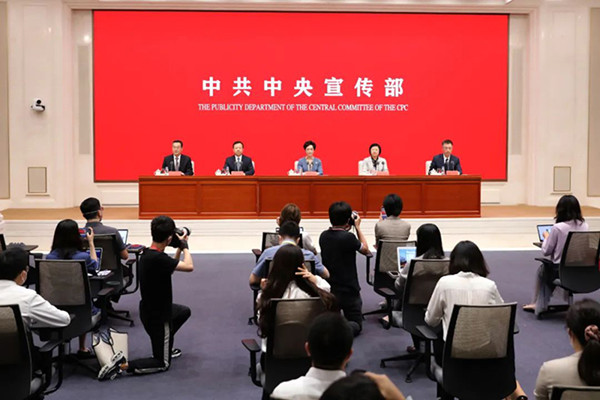Chinese courts provide better judicial service over the last decade
The Publicity Department of the Communist Party of China (CPC) Central Committee held a press conference on July 12 to introduce the measures and achievements of the people's courts over the last decade. Vice presidents of the Supreme People's Court (SPC) Tao Kaiyuan, Yang Linping, He Xiaorong and Shen Liang attended the event and took questions from the media.
Since the 18th National Congress of the CPC in 2012, courts in China have striven for judicial justice for the people and provided strong judicial services and guarantees in the building of a modern socialist country in all aspects. The number of cases accepted increased from 14.217 million in 2013 to 33.516 million in 2021, with the settlement amount for concluded cases reaching 46.7 trillion yuan ($690.81 billion).

The courts' work was highlighted from the following six perspectives.
Insisting on the absolute leadership of the Party on judicial work. Courts nationwide have fully implemented the decisions of the CPC Central Committee in judicial practices.
Safeguarding national security and social stability in accordance with the law. A total of 36,000 cases of gang crimes were concluded between 2018 to 2021, involving 244,000 people. Harsh penalties were given to severely violent crimes such as murder, arson and kidnapping, which in turn kept the number of the crimes at a low level. Epidemic prevention related crimes were punished and a number of major wrongful convictions were corrected, securing stronger protection of human rights.
Serving the high-quality development of the economy in accordance with the law. Judicial protection of property rights have been strengthened. Equal protection was rendered to all market entities, in public and private sectors, domestically and internationally funded, and regardless of the size of enterprises, in order to foster a business environment that is based on market principles, governed by law and up to international standards. A "20-point" policy was released to substantially resolve disputes and relieve stresses on micro, small and medium-sized enterprises. IPR protection was strengthened to encourage innovation-driven development. The number of IP-related cases accepted by courts across the nation increased from 101,000 in 2013 to 577,000 in 2021, an annual increase of over 20 percent. A series of judicial interpretations in the financial area were released to secure steady and healthy financial development, and a legal framework was built to protect the ecological environment. Courts provided equal protection for the legitimate rights and interests of Chinese and foreign interested parties, in a bid to provide quality judicial service for the high-level opening-up.
Safeguarding the people's legitimate rights and interests in accordance with the law. Judicial interpretations and typical cases on crimes that draw wide public attention, such as telecom fraud, personal information infringement and high-rise littering, were timely released in a bid to safeguard the safety and wellbeing of the people. In the last decade, over 36 million cases concerning people’s livelihoods, such as education, employment, medical insurance, elderly care, housing and marital affairs, were heard and concluded. In 2021, courts across the nation executed and concluded 8.642 million cases, involving 1.94 trillion yuan. A total of 10. 84 million disputes were mediated and resolved online in 2021, with the number sitting at 5.773 million in the first six months of 2022. China has established a one-stop diversified dispute resolution and litigation service system with Chinese characteristics that has the most coordinated resources, the most comprehensive online mediation, and the widest range of audience.
Accelerating the construction of a socialist judicial system that is fair, efficient and authoritative. The responsibility system was fully implemented in all courts, and the judge quota system adopted. The classified management of judicial staff was improved, as well as the judicial oversight mechanism. The trial-based litigation system reform was deepened and the organizational framework of the people's courts improved. The smart court construction has been advanced where the three sets of regulations on online litigation, mediation and operation of people's courts were launched, and the directive to strengthen the judicial application of blockchain technologies issued.
Forging a judicial force with loyalty and integrity. Courts nationwide have striven for a regularized and professional judicial force that is strictly disciplined over the last decade.







